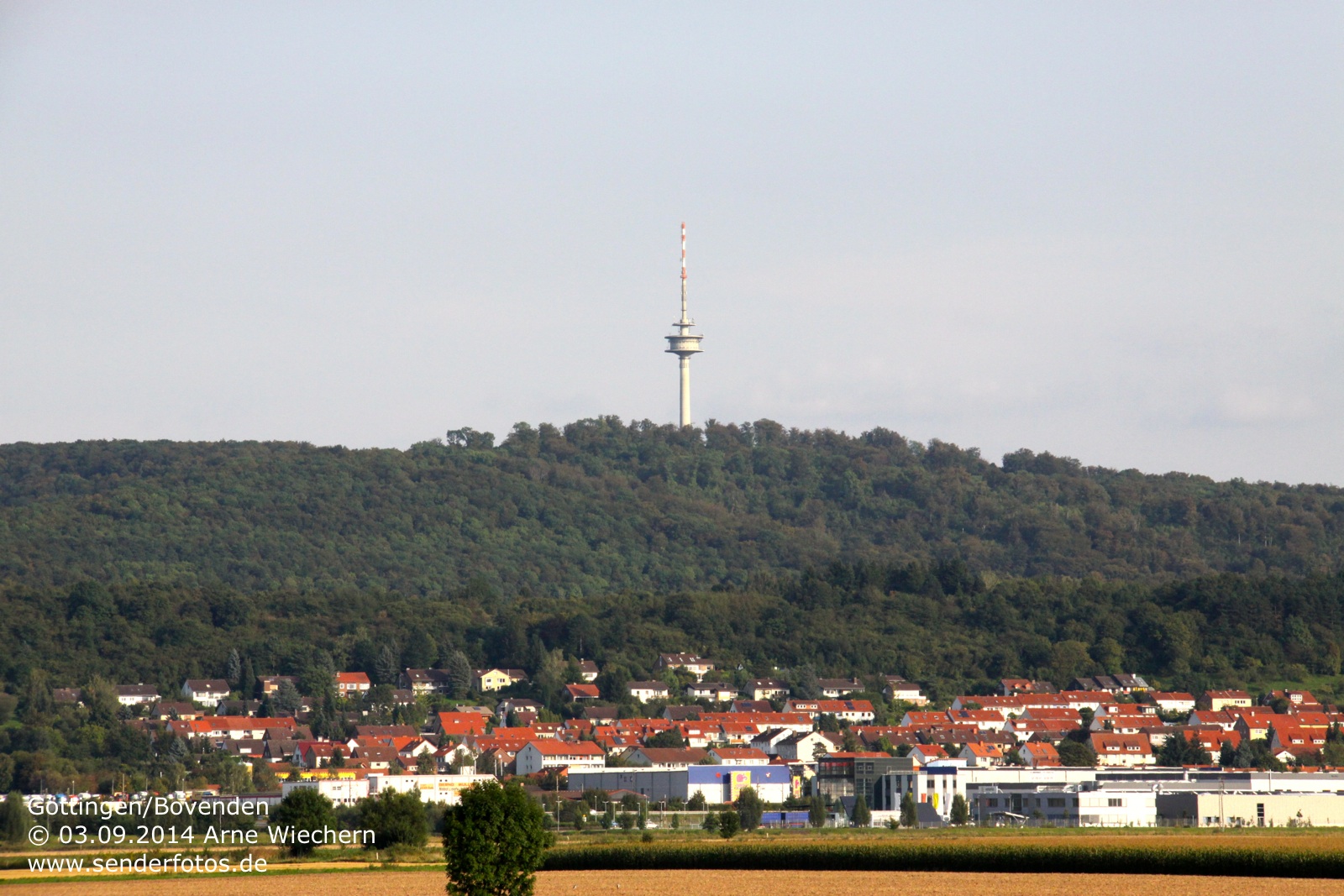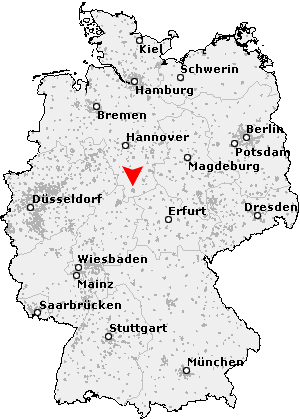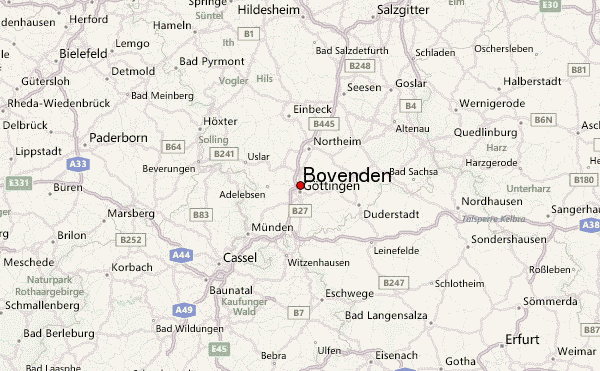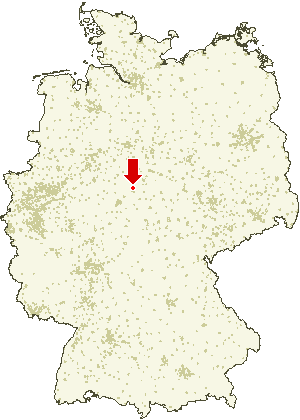Bovenden
The patch Bovenden is a municipality in the district of Göttingen in southern Lower Saxony ( Germany ).
The term patch is an official part of the name. The patch consists of the nucleus Bovenden and seven other districts. Some 14,000 residents have their main or secondary residence in spots Bovenden, of which 48 percent live in the nucleus Bovenden.
- 2.1 Population development
- 3.1 Ortsrat
- 3.2 Coat of Arms
- 5.1 Education 5.1.1 Basic School at Sonnenberg
- 5.1.2 School at the Osterberg
Geography
Bovenden lies on the northwestern foothills of the Göttingen Forest and the south-west of Nörtener Region approximately 6 km north of Göttingen. The nucleus Bovenden located between the Osterberg and the Keuper back of Lieth in the Valley of running in north-south direction line. On the eastern shore of the running in the same direction Weende which opens a few kilometers further north in the lanyard. Above and to the east of the district Eddigehausen stands the ruined medieval castle Plesse.
Spot outline
- Billingshausen
- Bovenden, the nucleus
- Eddigehausen
- Emmenhausen
- Harste
- Lenglern
- Reyershausen
- Spanbeck
Ortswüstungen
In addition to the existing villages still counted once following places to Bovenden, but in the late Middle Ages were desolate.
- Rodershausen or harvester Husen (2 km northwest of Bovenden )
- Aspe or Aspa (1 km northeast of Spanbeck )
- Botleveshusen (0,2 km west of Maria Spring)
- Back Husen (1,2 km east of Reyershausen )
- Sturmbeke or Stumbeke ( 0.9 km west of Reyershausen )
History
The first written mention of the village Bovenden is delivered in a charter of Otto the Great on 2 February 949, in the later Emperor notarized an exchange transaction with the Hersfeld Abbey. The name was there Bobbenzunon and is later than Bobbantun ( 1141 forgery of the 13th century ), Bobentun ( 1170 ) and Bobentum ( 1191 ), handed down since the 13th century as Boventen and since the late 16th century in its present form. The Namensherleitung is still controversial, obvious is an interpretation as the composition of a personal name Bovo, Bob ( b ) o the suffix "- do " with the suffix - do ( is in Low German for " fence containment ", or " fenced area " - hence also the English " town" ), ie an entity created or controlled by Bobo be cherished settlement. Another interpretation is not of a personal name, but of the tribe bioðan ( = "above", see Low German boven ) from, so be harbored a settlement above the flood plain of the leash.
From the 12th century occurs for the first time to the noble lord family of the lords of Boventen whose earliest mention comes in a document from the year 1170. In this document, when it comes to donations around Bovenden to the monastery Helmershausen, a Bodo von Boventen is enumerated in a series of witnesses, from 1211 then pass the Lords of Boventen as patrons of the local chapel. In the following decades, the family succeeded by Boventen to expand their goods, so they already had vast estates in the wider area around the middle of the 13th century, but their capital was Bovenden in which it 7 yards, 11 1/2 hooves country and 2 meadows and their castle had. Outside of their home town they came as Burgmannen on the Hardenberg, were the main hiss and services were often witnesses among hard salvors. However, the proximity to Kurmainz not prevented the assumptions of Bovenden also fief of Guelph. In the 14th century they changed then more and more in the braunschweiger bearing on, for example, knight Günther Bovenden praised the Duke Otto of Brunswick, 1364 against anyone except the Archbishop of Mainz, to be helpful and if Duke Otto them from their alliance with Kurmainz could exempt only to serve him. For two centuries the lords of Boventen had significant influence on the fortunes of the place, until they gradually lost its importance at the end of the 14th century. Only one line, the one on Lenglern led after 1500 passes the name. The possessions of the lords of Boventen referred to in documents as nobiles and miles, switched over to the noblemen of Plesse. In Bovender arms today, remembers the key to the main office of the hiss Burgmannen on the Hardenberg.
Since the 14th century the lords of Plesse as the most important landowners in Bovenden are detectable. Your entire estate she wore on October 28, 1447 on the Landgrave Ludwig I of Hesse and got it from this as Erbmannlehen back. In this way they could against the Duchy of Brunswick -Lüneburg maintain a higher degree of self-determination. After the extinction of Plesser 1571 rule Plesse fell to Hesse- Kassel, and was now a Hessian enclave. Since the 16th century Bovenden got as the most important place of dominion Plesse more rights: By John Letzner it was in 1587 first described as spots, which at least indicates a market law, and in 1605 was awarded the right to brew beer.
After the abandonment of the castle Plesse 1660 was Bovenden administrative headquarters, a new office building was built from 1777 as a representative baroque complex on the site of two former Meier courtyards of the monastery Steina. The representation and management tasks were performed in this Hessian castle until 1815, it served as the hunting lodge of the Landgrave of Hesse -Rotenburg. The location as an enclave offered various professions special development opportunities. Since 1860, the State Forestry Service Bovenden is housed in the building until 1859, it served as the administrative headquarters of the then defunct Hanover Office Bovenden.
In connection with the formation of the Göttingen Georg -August- University Bovenden also experienced in the second half of the 18th century an economic boom. Many students came to the place that was still an enclave of Hesse- Kassel to be there to watch propelled theater groups to dine in the restaurant "Zum last penny " and in the Ausflugsgaststätte noise water or with wine, brandy, coffee and sugar to stock, which were provided in Göttingen with a luxury tax. In the course of these events, which were considered by the authorities of the University of Göttingen as a waste of time, and debt debauchery Make the students, there was talk then of the " Bovender danger".
As part of the community and local government reform, the eight villages Eddigehausen, Emmenhausen, Harste Lenglern, Upper Billingshausen, Reyershausen, Spanbeck and the previously located in the district of Northeim Under Billingshausen were incorporated into the town Bovenden on 1 January 1973.
Population Development
Development of the population in the nucleus Bovenden:
Policy
Ortsrat
The Ortsrat is made up of 11 council women and councilors.
- CDU: 3 seats
- SPD: 4 seats
- Green: 2 seats
- FDP: 1 seat
- FWG: 1 seat
(As at municipal election on September 11, 2011)
Mayor of spots Bovenden since 1997 Heidrun baker (SPD).
Coat of arms
Blazon: " The coat of arms depicts an upright made in yellow field blue key, beard after pointing left, overlapped with an underlying red wall anchors. " The wall anchor refers to the arms of the noblemen of Plesse that until their extinction in 1571 owner of the rule plesse were. Already they had in the earliest form of its crest to in that a transverse double red house anchor on a gold shield. Those two colors have been preserved in the municipal coat of arms. The set upright blue key refers to the arms of the former residents in the village lords of Boventen. Your plate was divided blue - silver on the front, showed a gold or silver lion, while the background contained a black wooden keys. The one patch on the coat of arms helmet showed a blue silver open flight or two diagonally crossed black keys. The current coat of arms took the key in blue, thus taking one of the primary colors of the coat of arms of the lords of Boventen on.
Culture and sights
There is an extensive hiking trail in the area of Lohberges. On the crest of Lohberges is also stretched to a length of about 300 m, the former Jewish cemetery, which was built around the year 1680 and on the grave stones are still 65 to be found today. The oldest hail from the 1770s and 1780s, during the most recent date to the year 1926. Although located in the Bovender field mark parcels with the name in the Jews basically, first mentioned in 1571, and the Jews called Kirchoff 1605, but can be detected at either location a former cemetery. Further evidence for a one term Jewish life in Bovenden delivered to its demolition in 1845, a mikveh, which was located behind the house in the Lower 74, as well as a former outhouse, which served as a synagogue and school house and was in the Broad Street 19, however, was sold in 1922 and 1960 canceled.
Bovenden lies at Solling resin cross walk. Furthermore, there is plenty of sporting activities including a sports center, tennis courts, an indoor tennis court, a bowling center and a sports tournament course with riding hall.
The yew forest on the mountain grove, just east of the village core Bovenden and south of the district Eddigehausen located, is one of the largest natural residual populations of the European yew tree in Germany. The habitat is classified as a natural monument and easily accessible via the trails below the Plesseburg.
On the Osterberg ( 350m ) south of Eddigehausen is the transmitter Bovenden.
The community Bovenden is part of the German Fairytale Route, which runs from Hanau to Bremen Bovenden.
Economy and infrastructure
Education
Primary school at Sonnenberg
The primary school at Sonnenberg is one of two schools Bovendens. With the foundation stone for their construction on October 28, 1960 you also built the whole fourth school in the history Bovendens. The first students, teachers and the then headmaster, rector L. Spangenberg were able to move after only two years in the school. Other buildings that have been built around the school, were the gym with a gym and a bowling alley, as well as the caretaker house. However, the school space needs were, in the context of local extensions, quickly run out and so was built in 1963 two more classrooms to. A next phase of construction was followed in November of the same year, which was 1965 based. The fourth section was built in 1967, with which the school took its present form. The design of the outdoor facilities dragged on until 1973, initially was inaugurated a third playground before finally a 50,000 m2 large sports grounds, with a large and small game, training facilities for athletics, a football pitch and tennis courts, was come. Was realized the school after the " Frankfurt Model ", the ROCHE -lit classrooms, corridors and staircases, five separate inputs of the four classes and a corresponding color. The construction costs amounted to 3.4 million marks, and were the largest investment that had made the community patch until then. With the increase in population began in 1979 with the construction of a new school center. Thither was divided to categories 5 and 6 of the orientation level to 1981 from the summer of 1982 was followed by the main school. The vacant spaces of the primary school building took a Waldorf kindergarten, the county adult education center and a school- children's home of the AWO. Today, about 240 students in the two - to three spacious school system, in 11 classes taught by 15 teachers.
School at the Osterberg
The construction of school at the Osterberg was started in November 1979, after agreement had been reached between the city of Göttingen and the communities Norten -Hardenberg, and Bovenden on the Bovender location of a new school center. The center at the root Bruchwegstadion was provided for two independent schools, the orientation stage and the primary and secondary school. The former was able to resume operations as early as in August 1980, the construction lasted for a total to the year 1982. The work between the elementary and secondary school forms has always been is a narrow organizational unit, even if both types of schools are strictly separated and have their own timetables. A problem arises in a long time, the class division out, for which there is only one eighth class of high school, but two could be set up in secondary school branch. The school is designed to offer more practical stresses for the main student so they can, for example, perceive an offer of the vocational schools 2 in Gottingen and participate in a career choice week in the snows. The Realschule confronted her students but only from 9 school year with the professional world. Here play foreign languages, such as English and French, a stronger role. Overall, the number of students amounted to 230 to 240 students, of which about 90 students attend the main school. The intersection is stated that about a year 60 to 70 students leave school, of which 5 and 6 with no degree, 15 to 20 have the High school, 25 to 30 the high-school diploma, with about 12 the Enlarged I. erreichen.An secondary education teachers teach 18 teachers at the school, in 1989 there were 28 teachers who have taught partly Saturday sometimes 6 hours. Today, the weekly lessons have leveled off at 374. With the beginning of the school year 2010/2011 the school was converted into an IGS, so that the outgoing principal and junior high school only from the class exists 9 (February 2013). The school received its name as part of the conversion school at the Osterberg, or IGS Bovenden.
The new IGS leads now in the 5th, 6th, 7th and 8th grade (as of February 2013) in five classes for each year about 500 students, who teaches a team of nearly 40 teachers. It is located next to the main and high-school diploma through cooperation with other comprehensive schools in the Advanced lower secondary education and the high school. In autumn 2012 a new building was inaugurated in order to provide appropriate classrooms for the expansion of student numbers.
Traffic
Although the old north-south route between Hanover and Göttingen and the high-speed line Hannover -Würzburg pass right through Bovenden, there is no train station. The two routes and the main road 3 run on 400 m length in Bovender cover in the city through.
The district Lenglern has a break point on the railway line Göttingen- ground field.
Personalities
- Gertrud II of Boventhen († July 7, 1324 in Gernrode ), was from 1317 to 1324, the abbess of the combined pens of Gernrode and Frose
- Heinrich von Bovenden ( † around mid 1359 ) two-time Grand Commander of the Teutonic Order ( 1342-1346 and 1352-1356 ) and therefore the highest-ranking officer of the Order after the Grand Master
- Moritz Thilenius Gerhard (1745-1808), German spa doctor, was born in Eddigehausen and later kidnapped by his sovereign
- August Jordan (1872-1933), politician ( SPD)
- Wedig Kausch von Schmeling - baring (* 1934), conducted from 1972 to 1977, the Forestry Office Bovenden and lives since then in the patch
- Gabriele Lösekrug -Möller (* 1951), politician (SPD ), Member of Parliament










